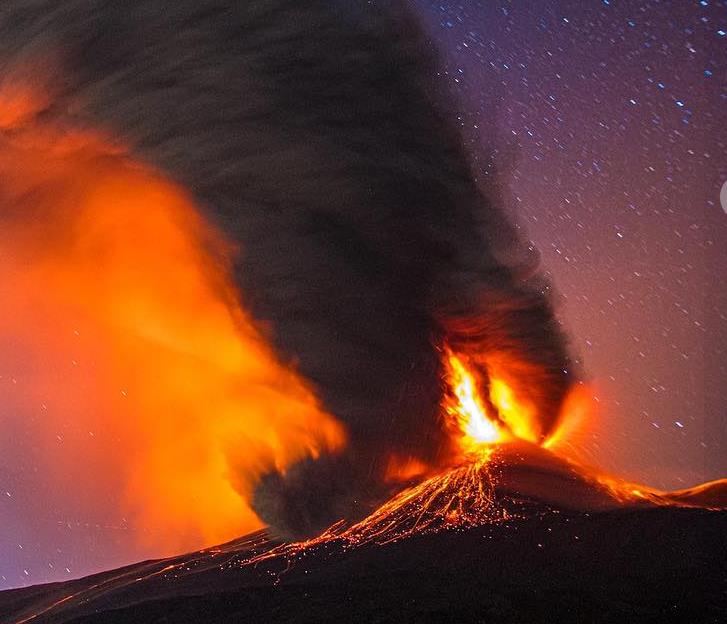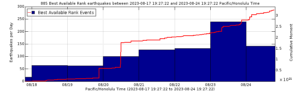 Seismic activity is still high south of Hawaii’s Kilauea summit caldera. Yesterday, there were 250 small tremors in just 24 hours. In Hawaii, it’s now 8:00 PM on August 24th, and more than 150 earthquakes have been recorded so far. Though it’s unlikely to reach the previous day’s high count, earthquake activity remains elevated. Ground deformation is also increasing significantly, rebounding from a slight dip 2 days ago. Since last September, the ground has risen by about 65 cm, despite previous lava activity. The volcano’s magma chamber couldn’t be emptied enough to reduce the uplift. The erupted lava filled Halema’uma’u crater by 400 meters. A new graph shows current measurements of the crater’s depth using a laser rangefinder. This depth is measured against the point after the 2018 Leilani eruption collapse when the crater was at 518 meters above sea level.
Seismic activity is still high south of Hawaii’s Kilauea summit caldera. Yesterday, there were 250 small tremors in just 24 hours. In Hawaii, it’s now 8:00 PM on August 24th, and more than 150 earthquakes have been recorded so far. Though it’s unlikely to reach the previous day’s high count, earthquake activity remains elevated. Ground deformation is also increasing significantly, rebounding from a slight dip 2 days ago. Since last September, the ground has risen by about 65 cm, despite previous lava activity. The volcano’s magma chamber couldn’t be emptied enough to reduce the uplift. The erupted lava filled Halema’uma’u crater by 400 meters. A new graph shows current measurements of the crater’s depth using a laser rangefinder. This depth is measured against the point after the 2018 Leilani eruption collapse when the crater was at 518 meters above sea level.
 Marc Szeglat
Marc Szeglat
Mount Dempo Volcano in Sumatra with phreatic eruption
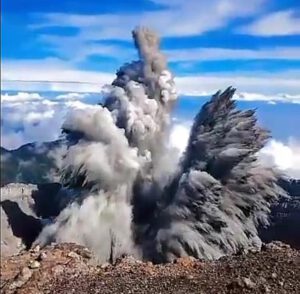 Yesterday, the VSI reported that there was an eruption at Mount Dempo volcano on Sumatra. A seismic signal was recorded, with a strong shaking that lasted for about 3 minutes. This signal was detected at 9:05 AM local time. At first, there was no visual confirmation of the eruption. However, a video showing the eruption was shared on the social media platform ‘X’ this morning.
Yesterday, the VSI reported that there was an eruption at Mount Dempo volcano on Sumatra. A seismic signal was recorded, with a strong shaking that lasted for about 3 minutes. This signal was detected at 9:05 AM local time. At first, there was no visual confirmation of the eruption. However, a video showing the eruption was shared on the social media platform ‘X’ this morning.
Last year, there were signs that the volcano might become active again when there was a sudden burst of steam and gas in May. In January 2022, the alert level was raised to ‘yellow’ due to some shaking underground. There were some smaller eruptions at the end of July this year, but I missed them because I was traveling in Kenya. An ash cloud was seen rising up to 2 km above the volcano’s opening on July 25, 2023. There were also more earthquakes than usual on that day. It’s possible that the volcano is slowly getting ready for bigger eruptions.
Lavadome on Mayon remain active
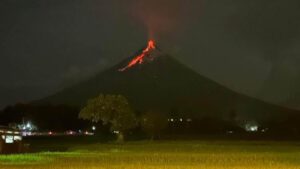 On the Philippine island of Luzon, Mayon continues to remain active, erupting a lava dome. Three lava flows emanate from the dome, flowing through the channels of Bonga, Mi-isi, and Basud, measuring 3.4 km, 2.8 km, and 1.1 km in length, respectively. Both lava flows and the dome are generating rock avalanches that leave glowing traces in nighttime images. Yesterday, 127 of these rock avalanches were recorded by seismographs. Additionally, signals from 6 pyroclastic flows were detected, resulting from larger collapse events and traveling up to 4 km. Ash clouds reached altitudes of up to 3 km. Mayon also remains seismically active, with 35 volcano-related earthquakes detected. Among these events, 20 were characterized as tremor signals, lasting for up to 80 minutes. Tremors are caused by fluid movements underground, indicating the presence of more magma in transit. This is further indicated by a high concentration of gaseous sulfur dioxide. In the last 24 hours, 1467 tons of this gas were emitted. A steam plume rose up to 700 m above the dome. The volcanic structure of Mayon is swollen, and inflation is occurring.
On the Philippine island of Luzon, Mayon continues to remain active, erupting a lava dome. Three lava flows emanate from the dome, flowing through the channels of Bonga, Mi-isi, and Basud, measuring 3.4 km, 2.8 km, and 1.1 km in length, respectively. Both lava flows and the dome are generating rock avalanches that leave glowing traces in nighttime images. Yesterday, 127 of these rock avalanches were recorded by seismographs. Additionally, signals from 6 pyroclastic flows were detected, resulting from larger collapse events and traveling up to 4 km. Ash clouds reached altitudes of up to 3 km. Mayon also remains seismically active, with 35 volcano-related earthquakes detected. Among these events, 20 were characterized as tremor signals, lasting for up to 80 minutes. Tremors are caused by fluid movements underground, indicating the presence of more magma in transit. This is further indicated by a high concentration of gaseous sulfur dioxide. In the last 24 hours, 1467 tons of this gas were emitted. A steam plume rose up to 700 m above the dome. The volcanic structure of Mayon is swollen, and inflation is occurring.
Mount Etna unexpectedly produced a paroxysmal eruption
Once again, the spectacular scene of a paroxysmal eruption from the new Southeast Crater could be admired on Mount Etna. The eruption began in the evening around 8:30 PM UTC (Central European Summer Time +2 hours) with Strombolian activity from the volcano. This activity rapidly intensified, and just an hour later, ash clouds started to rise, reaching up to 1000 meters above the crater’s elevation, as reported by the Toulouse VAAC. The main phase of the paroxysm then began around 12:00 AM UTC and reached its peak around 1:20 AM UTC. During this phase, ash was ejected to a height of 6100 meters, and a lava fountain several hundred meters high illuminated the night sky over Sicily. By 3:20 AM UTC, the lava fountain collapsed, but ash continued to rise. An hour later, the ash reached a height of 8200 meters and drifted southward. The ash emissions ended around 5:50 AM UTC. The lava fountain activity was accompanied by a lava overflow, with the lava flow not heading into Valle del Bove but rather towards the southwest. This corresponds to the path from the vent in the new Southeast Crater that previous lava flows had taken.
Stromboli with further lava overflo
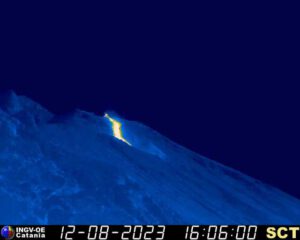 Yesterday morning, another lava flow formed at Stromboli, spilling from a vent in the northeastern crater sector. Similar to previous episodes, there were no significant changes in geophysical parameters leading up to the increase in activity, except for a rise in tremor amplitude. The accompanying graph shows a corresponding peak reaching into the lower red range, although it didn’t reach the value of the previous episode, which was accompanied by a stronger explosive eruption. Photos document that the current episode was also marked by lively Strombolian activity and lava spattering. The activity began increasing during the morning hours. By noon, the lava flow was only 100 meters long. Rock avalanches originated from its front.
Yesterday morning, another lava flow formed at Stromboli, spilling from a vent in the northeastern crater sector. Similar to previous episodes, there were no significant changes in geophysical parameters leading up to the increase in activity, except for a rise in tremor amplitude. The accompanying graph shows a corresponding peak reaching into the lower red range, although it didn’t reach the value of the previous episode, which was accompanied by a stronger explosive eruption. Photos document that the current episode was also marked by lively Strombolian activity and lava spattering. The activity began increasing during the morning hours. By noon, the lava flow was only 100 meters long. Rock avalanches originated from its front.
Moderate earthquake shakes Greek island Crete
Date: 08/13/23 | Time: 07:49:32 UTC | Coordinates: 35.247 ; 23.878 | Depth: 10 km | Magnitude: 4.6
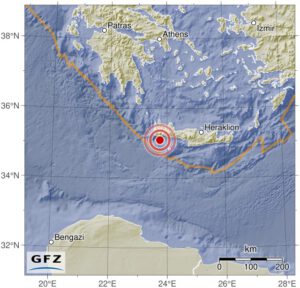 The Greek holiday island of Crete was shaken by a moderate earthquake with a magnitude of 4.6 this morning. The hypocenter was located at a depth of 10 km by the EMSC. This depth is often provided when it is certain that the earthquake occurred in shallow areas of the Earth’s crust, but the exact depth has not (yet) been determined. The epicenter was a few kilometers from the southwest coast and was located 18 km east-northeast of Palaióchora. The island’s capital, Heraklion, is 115 km away from the epicenter. Aftershocks can be expected.
The Greek holiday island of Crete was shaken by a moderate earthquake with a magnitude of 4.6 this morning. The hypocenter was located at a depth of 10 km by the EMSC. This depth is often provided when it is certain that the earthquake occurred in shallow areas of the Earth’s crust, but the exact depth has not (yet) been determined. The epicenter was a few kilometers from the southwest coast and was located 18 km east-northeast of Palaióchora. The island’s capital, Heraklion, is 115 km away from the epicenter. Aftershocks can be expected.
Lava dome at Mayon is growing
 Mayon volcano on Luzon island in the Philippines remains active, building up its lava dome. It has produced three lava flows, the longest of which has traveled a distance of 3.4 km. These flows follow the channels of Bonga, Mi-isi, and Basud. Yesterday, seven pyroclastic density currents were reported, covering a distance of up to 4 km. Additionally, 201 debris avalanches were recorded. An ash eruption was also observed, sending volcanic ash up to an altitude of 3000 m.
Mayon volcano on Luzon island in the Philippines remains active, building up its lava dome. It has produced three lava flows, the longest of which has traveled a distance of 3.4 km. These flows follow the channels of Bonga, Mi-isi, and Basud. Yesterday, seven pyroclastic density currents were reported, covering a distance of up to 4 km. Additionally, 201 debris avalanches were recorded. An ash eruption was also observed, sending volcanic ash up to an altitude of 3000 m.
The seismic network of PHILVOLCS detected 100 volcano-related earthquakes. Among these, 58 were tremor phases caused by magma movements underground. Some of these tremors lasted up to 13 minutes, suggesting that the volcano does not intend to decrease its activity in the near future.
Gas emissions reached 1888 tons per day yesterday, which is a significant amount. Steam rose up to 800 m above the height of the dome.
Overall, ground deformation due to magma inflation is being observed. However, in the eastern part of the volcanic area, the opposite trend of deflation is occurring. It’s likely that the magma erupting at the dome currently originates from this sector.
Mayon is an active stratovolcano located on the island of Luzon in the Philippines. It is known for its nearly perfect cone shape and is one of the most iconic and picturesque volcanoes in the country.
Earthquake M 5.2 in Turkey
Date: 10th August 2023 | Time: 17:48:00 UTC | Location: 38.267 ; 38.265 | Depth: 11 km | Magnitude: 5.2
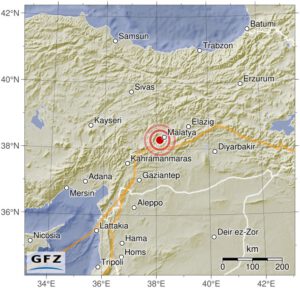 Once again, an earthquake occurred along the East Anatolian Fault in southeastern Turkey. The moderate earthquake reached a magnitude of 5.2 on the Richter scale and had its hypocenter at a depth of 11 km. The epicenter was located about 10 km south-southwest of the town of Malatya. Local media report at least 23 injured individuals. The earthquake took place at 17:48:00 UTC, affecting a region that had already been severely impacted by the strong earthquake near Gaziantep. The infrastructure of Malatya had already been heavily damaged, which is why the recent moderate earthquake caused further harm and led to the injuries.
Once again, an earthquake occurred along the East Anatolian Fault in southeastern Turkey. The moderate earthquake reached a magnitude of 5.2 on the Richter scale and had its hypocenter at a depth of 11 km. The epicenter was located about 10 km south-southwest of the town of Malatya. Local media report at least 23 injured individuals. The earthquake took place at 17:48:00 UTC, affecting a region that had already been severely impacted by the strong earthquake near Gaziantep. The infrastructure of Malatya had already been heavily damaged, which is why the recent moderate earthquake caused further harm and led to the injuries.
Fuego erupts ash up to 5200 m altitude
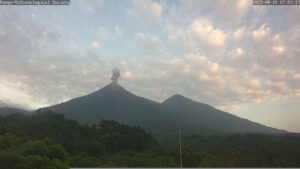 In Guatemala, the Fuego volcano has become more active again compared to the past few weeks. Today, the VAAC issued a VONA warning stating that volcanic ash has risen up to an altitude of 5200 m. The wind has carried the ash cloud in a western direction, leading to ashfall in the communities in that direction.
In Guatemala, the Fuego volcano has become more active again compared to the past few weeks. Today, the VAAC issued a VONA warning stating that volcanic ash has risen up to an altitude of 5200 m. The wind has carried the ash cloud in a western direction, leading to ashfall in the communities in that direction.
The volcanologists from INSIVUMEH released their observations in a daily update yesterday. They reported 5 to 8 eruptions per hour on the previous day, with ash clouds reaching an altitude of up to 4700 m. The ash has shifted up to 15 km to the west, causing light ashfall in areas such as Finca Palo Verde, Sangre de Cristo, San Pedro Yepocapa, and Acatenango.
Karangetang with numerous rock avalanches
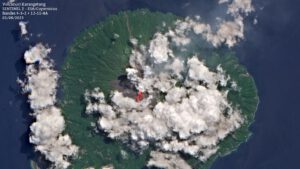 The dome in the southern crater of the Indonesian volcano Karangetang continues to grow, and numerous rock avalanches are occurring, leaving glowing traces in nighttime images. There are also signs of a sluggish lava flow making its way down the southern flank. On long-exposure photos, the glowing traces of the rock avalanches are not always distinguishable from lava flows. A daytime image shows bluish gas emissions emanating from the flank, indicating a lava flow. A satellite photo from August 1st reveals two thermal anomalies in the infrared range, possibly originating from lava flows. The distinction between rock avalanches and lava flows is uncertain here as well.
The dome in the southern crater of the Indonesian volcano Karangetang continues to grow, and numerous rock avalanches are occurring, leaving glowing traces in nighttime images. There are also signs of a sluggish lava flow making its way down the southern flank. On long-exposure photos, the glowing traces of the rock avalanches are not always distinguishable from lava flows. A daytime image shows bluish gas emissions emanating from the flank, indicating a lava flow. A satellite photo from August 1st reveals two thermal anomalies in the infrared range, possibly originating from lava flows. The distinction between rock avalanches and lava flows is uncertain here as well.
